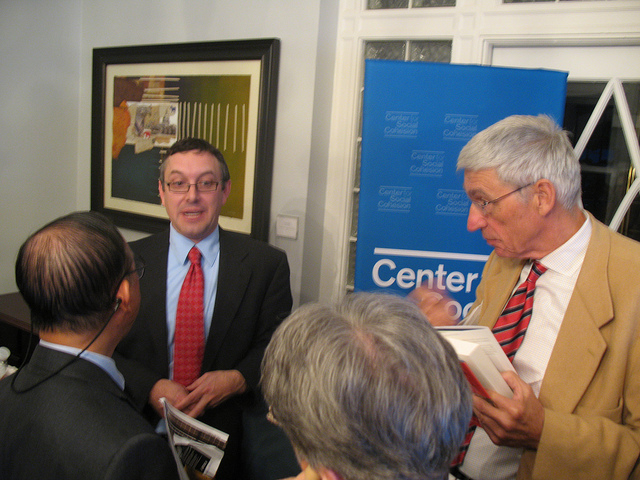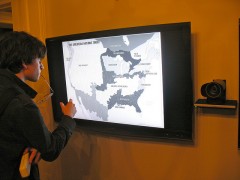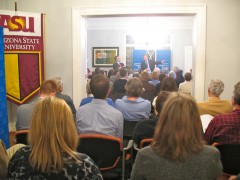
The Seal of the United States promises one nation formed from many–e pluribus unum. But journalist Colin Woodard says the reality is different: America is 11 distinct nations.
“We never really were one nation,” Woodard, author of American Nations: A History of the Eleven Rival Regional Cultures of North America, told a full house Monday night at Arizona State University’s Washington Center in Washington, DC.
Woodard–in a conversation sponsored by the Center for Social Cohesion and moderated by Zócalo Public Square editorial director Andrés Martinez–said he realized North America was much more complex than its political boundaries after he spent time as a foreign correspondent in the Balkan Peninsula, where cultural ties, not state borders, determine how people live. Upon moving back to the United States, he noticed stark differences in peoples’ values from one region of the country to the next and realized again that state borders didn’t give much insight into the people who lived there.
Woodard identified those ideals and studied their histories to create a new map of North America divided into 11 different nations. The nations date back to colonial times, when different groups of European settlers came to the New World with different religious and political goals in mind.

For example, the nation Woodard calls Yankeedom spans New England, the Great Lakes, and the Upper Midwest–and is one of North America’s superpowers. Calvinists founded this “nation” as a religious experiment in whether social engineering would make the world a better place.
“From the beginning the idea was that you could perfect earthly society and make it more godly,” Woodard said. The legacy of this experiment is an American region with strong public institutions designed to improve society.
Just south of Yankeedom on the East Coast lies New Netherland, made up of the New York City area, New Jersey, and parts of eastern Pennsylvania. The Dutch founded New Netherland as a trading post for their global trading society. Today it is a global financial center.
Another nation, the Midlands, starts in Pennsylvania and runs through the Rust Belt, into the Great Plains, and up to southern Canada. The Midlands was another religious experiment, but along different lines than those pursued by the Calvinists of Yankeedom. Founded by the original Quakers in Pennsylvania, the Midlands historically welcomed immigrants and people of different beliefs.
“It essentially became, from the beginning … a mosaic where no one group was particularly in charge,” Woodard said. This history has shaped American politics by establishing the idea of American identity as the ability of different people to live comfortably next to each other. Politically, this region has been full of swing states, where the existence of a variety of beliefs means whoever can win a slight majority often wins the day.
“If you were planning out a national election, look at the Midlands,” Woodard said.
To the south, a fourth nation, dubbed Tidewater by Woodard, encompasses the Chesapeake area, the eastern half of Virginia, and the northern border of North Carolina. It was settled by the younger sons of English gentry who recreated the English hierarchy. As they embraced the idea of aristocracy, they emphasized the importance of property and agriculture that defined much of the region and separated the north and south early on in American history.
A fifth nation, Appalachia, runs through much of the center of the continent. It started as a warrior culture because of the challenges of governing the mountainous region. Today that sentiment survives as a strong commitment to personal sovereignty.
A sixth nation–the Deep South–was founded by farmers from Barbados as a West Indies slave society, albeit one modeled after the Roman Republic, with a rigid caste system that was an unchanging fact of life. While the structure of society has changed in the Deep South, its distinct ideological history keeps it at odds with Yankeedom.
Woodard touched on the nations of New France (in Louisiana and eastern Canada), El Norte (the New Mexico area), and First Nation in northern Canada. But he put more emphasis on the two Western regions–which he calls the Far West and the Left Coast.
These regions, he said, are “hybrid, second-generation locations.”
Heat, drought, and distance were such difficult challenges in the early Far West (including northern Arizona and the interiors of California, Washington, and Oregon) that they trumped social forces like ethnicity. The people had to latch on to capitalist endeavors like the railroad and the gold rush to survive. Their economic dependence on the eastern regions essentially turned the Far West into a colony, Woodard said, which fostered resentment of the federal government that continues today.

Finally, the Left Coast (a skinny nation extending along the Pacific from Monterey, California to Juneau, Alaska), which was founded earlier than the Far West, was an experiment by the people of Yankeedom to establish yet another light on the hill. Their experiment, however, was thwarted by another gold rush and the arrival of many settlers from the Appalachians.
“The Left Coast combines the utopianism and the belief in the possibility of social reform of Yankeedom with a emphasis on individual self discovery and actualization that comes from the Appalachians,” Woodard said.
Taking all of this together, Woodard said it’s important to see that the cultures don’t change over time, and their values and expectations are passed down as a sort of cultural DNA.
Martinez, the moderator, noted that while cultural divisions in today’s political climate might support the claims of many different nations in America, it wasn’t that long ago that 49 of 50 states voted for Ronald Reagan for president. He asked what it is about today that makes the divisions so apparent.
Woodard answered that there have always been some periods of strong polarization and other periods of relative unity. The new development–seen only in recent decades–is the advance of coalitions among regions. For example, while we associate “red states” with the Far West, Appalachia, and the Deep South, it wasn’t long ago that the Far West was much more populist than it is today, and in the Civil War, Appalachia sided with Yankeedom over the Deep South.
“The nations tend to act together, but they act for different reasons in different situations,” he said. “This is another one of those moments where understanding what we’re fighting about would be handy.”
Overall, Woodard said his goal is to look past where we are now to what we can be in the future. What we need to recognize, he said, is that the federal government was created to facilitate compromise among the different groups in the United States.
“If we recognize that, I am optimistic that we will carry through and that there will be better dialogue,” he said.
Watch full video here.
See more photos here.
Buy the book: Skylight, Amazon, Powell’s.
Read Colin Woodard’s essay on how the 11 nations can help presidential candidates here.
Read expert opinions on our culture wars here.




Send A Letter To the Editors